the place where Paleontology and Paleoanthropology meets Philately
San Marino
Fossils and reconstructions of dinosaurs and other
prehistoric animals, as well as Charles Darwin and other
contributors to Paleontology on stamps and postmarks of San Marino
| << previous country | back to index | next country >> |
Contents:
- Country overview
- Philately of San Marino
- Official stamps of San Marino related to Paleontology
- Other stamps of San Marino to consider
- Commemorative postmarks of San Marino related to Paleontology
- Other postmarks of San Marino to consider
- References
- Acknowledgements
San Marino, officially the Republic of San Marino, also known as the Most Serene Republic of San Marino, is an enclaved microstate surrounded by Italy, situated on the Italian Peninsula on the northeastern side of the Apennine Mountains.
Its size is just over 61 km2, with a population of about 33,000. Its capital is the City of San Marino and its largest city is Dogana.
Geographically the third smallest state in Europe (after the Holy See and Monaco), San Marino also claims to be the world's oldest republic and has the smallest population of the ll members of the Council of Europe.
The country's economy mainly relies on finance, industry, services and tourism. It is one of the wealthiest countries in the world in terms of GDP (per capita), with a figure comparable to the most developed European regions.
San Marino is considered to have a highly stable economy, with one of the lowest unemployment rates in Europe, no national debt and a budget surplus. It is the only country with more vehicles than people. [R1]
The first San Marino postage stamps were a definitive stamp set consisting of two designs covering seven denominations. The stamps, which depict the Three Towers of San Marino at Monte Titano, were created by the design firm Fratelli Pellas in Genoa and the stamps were printed on Italian watermarked paper by the Officina Carta e Valori in Turin. Commemorative stamp editions were introduced in 1894. [R2]
Official stamps of San Marino related to Paleontology: dinosaurs and other prehistoric animals
| 30.06.1965"Prehistoric animals" [1] | ||
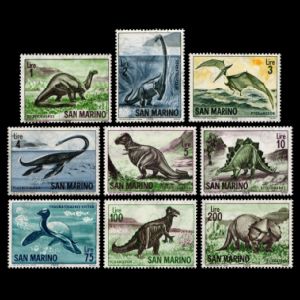 |
|
|
Notes:
[1] This set is one of the very first pictorial sets of Dinosaurs issued ever. There are a lot of FDCs with these stamps, perhaps all are personalized.
Other stamps of San Marino to consider: contributors to Paleontology, Charles Darwin, stylized prehistoric animals
| 21.04.1983 "Pioneers оf Science" [A1] | 08.04.2008 "European Year of Intercultural Dialogue" [A3] | 09.05.2012 "40th anniversary of UNESCO heritage" [A2] |
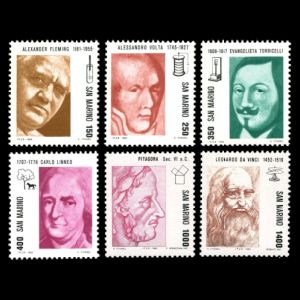 |
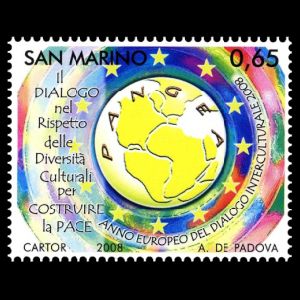 |
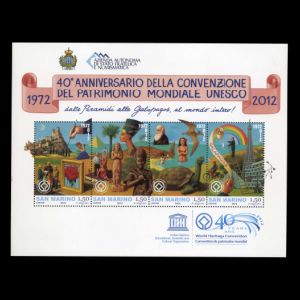 |
Notes:
[A1] Carl Linnei shown on a stamp with face value of 400 of "Pioneers of Science" set.
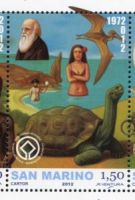
|
| Charles Darwin and Pteranodon on stamp of San Marino 2012 MiNr.: 2520, Scott: 1864c |
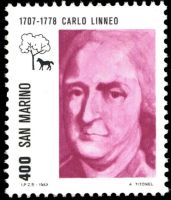
|
| Carl Linnaeus on stamp of San Marino 1983 MiNr.: 1274, Scott: 1044 |
He is known as the father of modern taxonomy, and is also considered one of the fathers of modern ecology.
[A2] Two stamps on the right side of the block are related to te Galapagos Islands. Charles Darwin and a Pteranodon (flying prehistoric reptile) are shown on one of them.
Pteranodon
is a genus of pterosaurs which included some of the largest
known flying reptiles, with wingspans over 6 metres.
It lived during the late Cretaceous geological period of North America in present day
Kansas, Alabama, Nebraska, Wyoming, and South Dakota.
More fossil specimens of Pteranodon have been found than any other pterosaur, with
about 1,200 specimens known to science, many of them well preserved
with nearly complete skulls and articulated skeletons.
Pteranodon was not a dinosaur.
By definition, all dinosaurs belong to either order
within Dinosauria, either Saurischia or Ornithischia.
As such, this excludes pterosaurs.
Nonetheless, Pteranodon is frequently featured in dinosaur media and is
strongly associated with dinosaurs by the general public.
[R3]
[A] The stamp from "European Year of Intercultural Dialogue" sheet of 3, San Marino 2008, shows Pangea, an ancient supercontinent.
Pangea, in early geologic time, a supercontinent that incorporated almost
all the landmasses on Earth.
Pangea was surrounded by a global ocean called Panthalassa, and it was
fully assembled by the Early Permian Epoch
(some 299 million to about 273 million years ago).
The supercontinent began to break apart about 200 million years ago, during the
Early Jurassic Epoch (201 million to 174 million years ago), eventually forming
the modern continents and the Atlantic and Indian oceans.
Pangea’s existence was first proposed in 1912 by German meteorologist
Alfred Wegener
as a part of his theory of continental drift.
Its name is derived from the Greek pangaia, meaning “all the Earth.”
[R6]
Commemorative postmarks of San Marino related to Paleontology: fossils.
Legend is here| 09.06.1979 "International Fossils and Minerals trade show" [Sp] [PM1] | ||
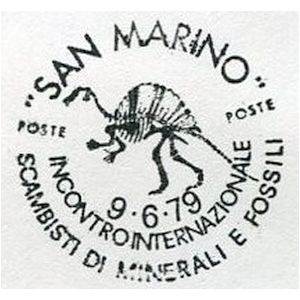
|
| |
Notes:
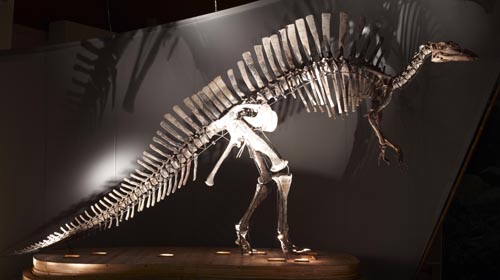
|
| Mounted sekeleton of Ouranosaurus nigeriensis from Venice's Natural Museum. Image credit: the museum website |
Fossils of the dinosaur were discovered by the Italian expedition, organized by the Italian entrepreneur and philanthropist Giancarlo Ligabue, founder of the Centro Studi e Ricerche Ligabue, Venice, who donated it to the museum. [R4]
Since 1975, a nearly complete mounted skeleton of Ouranosaurus nigeriensis has been exhibited at the Museo di Storia Naturale (Natural History Museum) of Venice, Italy. [R5]
Others commemorative postmarks of San Marino to consider.
Legend is here| 08.04.2008 "European Year of Intercultural Dialogue" [A4] [FDC] | ||

|
| |
References:
- [R1] San Marino:
Wikipedia,
WikiTravel,
Flag Counter
- [R2] Postal History and Philately of San Marino:
Wikipedia,
Links to official website of the Post Authority, stamp catalog and a list of new stamps of San Marino are here. - [R3] Pteranodon: Wikipedia.
- [R4] Ouranosaurus nigeriensis: "The Venice specimen of Ouranosaurus nigeriensis".
- [R5] Natural History Museum of Venice: official website.
- [R6] Pangea: Encyclopedia Britannica.
Acknowledgements:
- Many thanks to fellow collectors David Bressan from the USA and Ton van Eijden from the Netherlands for their help finding an information about the dinosaur shown on the postmarks from 1979.
- Many thanks to Dr. Peter Voice from Department of Geological and Environmental Sciences, Western Michigan University, for the draft page review and his valuable comments.
| << previous country | back to index | next country >> |